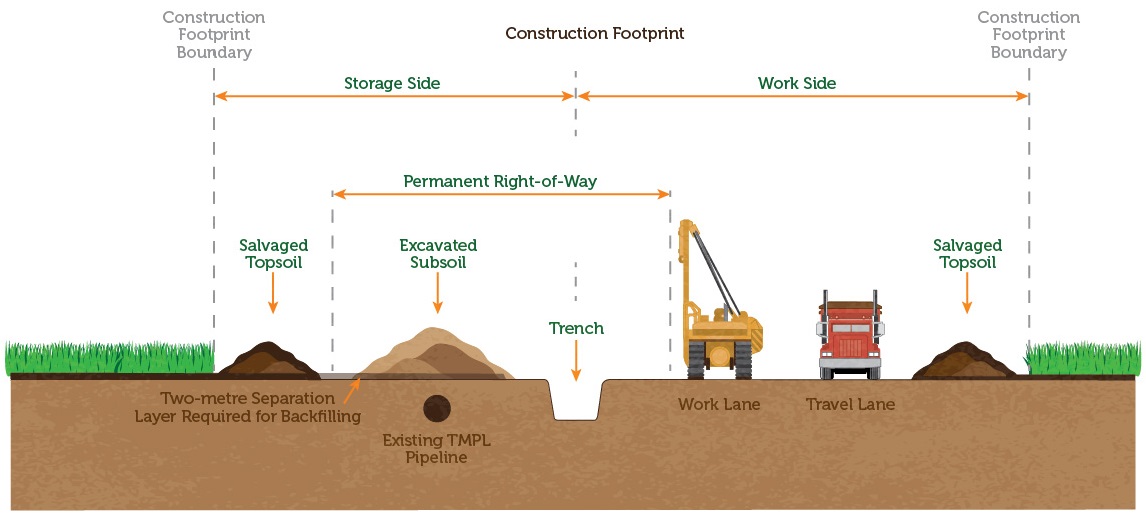Building the Trans Mountain Expansion Project
Pipeline construction is now underway, with Trans Mountain Corporation (TMC) anticipating that construction will be completed by late 2023.

The Trans Mountain Corporation (TMC) has hired over 13,500 people to work on sites in Alberta and British Columbia.
With a focus on Indigenous, local and regional workers, the project is providing good jobs for heavy equipment operators, trades people, environment and safety specialists, engineers and construction managers.
How does a pipeline get built?
The majority of the construction along the pipeline route is part of a 12-step conventional construction process. Explore the 12 steps and the other types of possible construction for a pipeline.

Text version
The graphic demonstrates the construction footprint during the conventional construction process which includes:
- Construction Footprint Boundary
- Storage Side
- Work Side
- Permanent Right-of-Way
- Salvaged Topsoil
- Excavated Subsoil
- Trench
- Two-metre Separation Layer Required for Backfilling
- Existing TMPL Pipeline
- Work Lane
- Travel Lane
Is construction taking place in your community?
Continued construction during COVID-19
Trans Mountain Corporation’s first priority is the health and safety of the workforce, their families and our communities. They are continuing the uninterrupted safe operation of the Trans Mountain Pipeline and construction of the project during COVID-19 while adhering to all advice and direction from government and health officials, both provincially and federally.
Find out more about what they are doing to continue construction and operations safely.
Explore construction activity on the Trans Mountain Corporation website

Text version
Map of the approved expansion of the Trans Mountain Pipeline. This map shows the route of the Trans Mountain Pipeline Expansion Project from just east of Edmonton, Alberta, to Burnaby, British Columbia, including the seven pipeline segments, the Hinton Hargreaves Reactivation Segment and the Darfield-Black Pines Reactivation Segment.
Subscribe to get the latest updates on construction
Work is progressing across the TMX project
As the proponent of the project and the operator of an existing pipeline, TMC remains subject to all applicable federal laws and regulatory requirements. TMC representatives were part of the Crown consultation and accommodation process and participated in meetings with Indigenous groups, where appropriate.
TMC continues to obtain additional regulatory approvals, which include:
- approvals from the Canada Energy Regulator to authorize the construction and continued operation of the pipelines
- authorizations under the Fisheries Act
- permits under the Species at Risk Act
- approval under the Indian Act to cross Indian reserves by Crown–Indigenous Relations and Northern Affairs Canada
- authorization under the Canadian Transportation Act for construction crossing a railway line
- approval and licensing issued under the Explosives Act
Looking for opportunities to work on TMX?
Learn more about contractors, project procurement and career opportunities with the Trans Mountain Corporation.
Overseeing the project
The Canada Energy Regulator (CER) is overseeing the condition compliance, project construction and operation and is responsible for holding TMC accountable to meet its commitments and applicable regulatory requirements, including the CER’s 156 conditions.
The CER will also hold TMC responsible for:
- keeping its pipelines and facilities safe and secure
- protecting people, property and the environment over the life of the project
The CER will continue to monitor and enforce implementation of the conditions, as amended by the Governor-in-Council, once the project is operational. To learn more about the conditions of the project, explore the CER’s Project Conditions Table.
Learn more about
What we’ve done
See our previous consultations and actions on the expansion project.
Who does what?
Learn more about the Government of Canada’s roles and responsibilities on the expansion project.
What informed the government’s decision
Find out what the government took into consideration when approving the TMX project.
Protecting the environment
Explore what the government is doing to take action on pipeline and marine safety.
Page details
- Date modified: